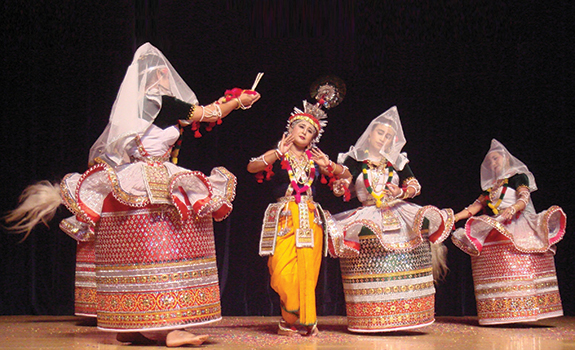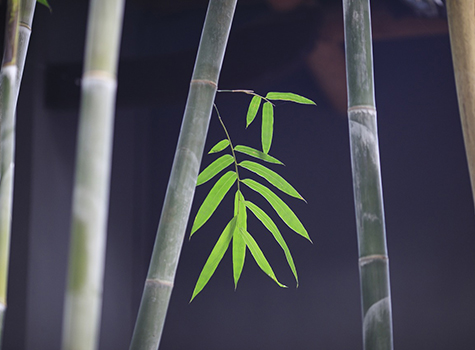By Dr. Maha Gingrich

We just celebrated Diwali festival, and the graceful, smooth, almost ballet like movements of Manipuri dance came to my mind. As you may know, there are many stories associated with Diwali. One is to celebrate the return of Lord Rama to the Kingdom of Ayodhya as a narrative of the victory of good over evil and the day of the festival is said to coincide with Rama’s triumphant return after defeating the demon king Ravana. Then also on Diwali day, people light up the night to guide Goddess Lakshmi into their homes to bring good fortune and prosperity for the year to come. Then there is the story of Lord Krishna’s victory over the powerful demon king Narakasura also holds particular significance to Diwali.
Manipuri dance is counted among major classical dance forms of India, especially noted for themes based on Vaishnavism and spectacular execution of Raas Leela dance dramas based on love between Radha and Lord Krishna. Other themes included in this art form associate with Shaktism, Shaivism and on the sylvan deities called Umang Lai during Manipuri festival of Lai Haraoba.
Situated on the northeastern region of India, Manipur presents a beautiful picture of nature and charm. The word Manipur is derived from the words “Mani” a jewel and “pur” a place. I wish we could see this beautiful, graceful and spiritual dance form more often. For centuries, people of Manipur have expressed their emotions and faith through dance and music.
A Bit of History
Traditionally the people of Manipur considered themselves to be the Gandharvas mentioned in the Vedic texts who were singers, dancers and musicians associated with devas or the deities. The region is also mentioned as Gandharva-desa in ancient Manipur texts. Although texts of ancient Manipur gradually fizzled out, the oral tradition of Manipuri, with records tracing back to early 18th century, have references about the place in Asian manuscripts and archaeological findings speak volumes about the art.
The British colonial rule in the 19th century saw decline of various Indian classical dance forms which were subjected to contemptuous fun and discouragement. Manipur was annexed by the British colonial government in 1891, and with this the flourishing period of Manipuri dance came under the clutch of colonial rule like other ancient Indian classical dance forms. The Manipuri dancers somehow survived in the temples of the region like the Govindji temple of Imphal. Many classical dance revivalists joined hands between 1920 and 1950 in reviving the different ancient classical dance forms.
Dance Style
The traditional style of this art form incorporates graceful, gentle and lyrical movements. The fundamental dance movement of Raas dances of Manipur is Chari or Chali. Manipuri dances are performed thrice in autumn from August to November and once in spring sometime around March-April, all on full moon nights. While Vasant Raas is scheduled in spring when Holi, the festival of colors is celebrated by the Hindus, the other dances are scheduled around post-harvest festivals like Diwali.
Themes of the songs and plays comprise of love and association of Radha and Krishna. One composition and dance sequence are dedicated for each of the Gopis/milkmaids while the longest sequence is emphasized on Radha and Krishna. The dance drama is performed through excellent display of expressions, hand gestures and body language. Acrobatic and vigorous dance movements are also displayed by Manipuri dancers in many other plays.
Costumes & Musicians
The costumes for Manipuri dancers, particularly for women are quite unique from other Indian classical dance forms. A male dancer wears a bright colored dhoti, also referred as dhora or dhotra that covers lower part of his body from waist. A crown decorated with peacock feather adorns the dancer’s head, who portrays the character of Lord Krishna.
The costume of female dancers resembles that of a Manipuri bride, referred as Potloi costumes. The most distinguished of these is the Kumil costume that is an exquisitely embellished long skirt in the shape of a barrel with a stiffened bottom. The top border of Kumil adorns a wavy and translucent fine skirt tied in three places around the waist in Trikasta and opens like a flower. A velvet choli or blouse adorns the upper part of the body and a translucent veil white in color covers the head. The dancer wears round shaped jewelry or garlands of flowers to adorn her face, hand, neck, waist, and legs that synchronize well with her costume. The unique aspect of this style, unlike other Indian classical dance forms, is that a Manipuri dancer does not wear a ghunghroo or bells.
The drummers, who also dance while drumming, are male artists. The musical instrument generally used in this art form includes the Pung that is a barrel drum, cymbals or kartals, harmonium, flute, pena and sembong. Accompanists also include a singer.
Through years, the classical dance form Manipuri has retained its heavenly beauty and rich content. This dance lives through its people as a vital part of their social, religious, and spiritual existence. Their deep religious faith and strict discipline in dancing has contributed to the continuation and retention of such purity in this style. I would love to see more people promote this beautiful dance form here in the USA.
For questions or comments, contact Dr. Maha Gingrich via email at [email protected]



